Municipal Forestry Foreman Drowns while on Emergency Duty during an Ice Storm - Massachusetts
Massachusetts Case Report: 08-MA-054
Release Date: June 11, 2010
Summary
On December 12, 2008 a 50-year-old male municipal forestry foreman (victim) drowned in a stream while on emergency duty during a storm. The victim had been on and off emergency duty throughout the night responding to calls of down trees and tree limbs. At the time of the incident, the victim was in the process of leaving the department of public works parking lot. While backing his work pickup truck, the truck backed over an embankment at the edge of the parking and partially down into a stream. It appears that when the victim exited the pickup truck, he fell into the water that then swept him down stream. The victim was found approximately two miles down stream by a search and rescue team the next day. The Massachusetts FACE Program concluded that to prevent similar occurrences in the future, employers should:
- Install barriers along parking lot perimeters that abut embankments;
- Conduct hazard assessments of outdoor workspaces to identify hazards and then develop and implement procedures to eliminate these hazards;
In addition, municipalities should:
- Develop, implement and enforce emergency procedures for tree-related incidents, especially during inclement weather, and provide employees training on these procedures; and
- Develop, implement, and enforce comprehensive health and safety programs that include training on hazard recognition and avoidance of unsafe conditions.
Introduction
On December 12, 2008, the Massachusetts FACE Program was alerted by the local media that earlier that same day a city department of public works employee was missing. The victim was performing tree cleanup during a rain and ice storm. The victim was found the following day in a stream by a search and rescue team. On February 18, 2009, the Massachusetts FACE Program Director traveled to the city’s department of public works and met with the department’s commissioner to discuss the incident. The police department report, death certificate, and other weather emergency fatality reports were reviewed during the course of the investigation. In addition the initial incident location was photographed.
The employer is a municipal department of public works for a city of over 36,000 residents. The department is split into multiple divisions that are all housed within one building. The victim was one of 19 employees within the forestry, parks and cemetery division. This division has one supervisor, four foremen, including the victim, and 14 special motor equipment operators/laborers. The victim was the foreman for the forestry group and was the direct supervisor of three laborers, two of whom were tree climbers. The forestry group of the division managed the care of the city-owned trees. The victim had been employed with the forestry group for 19 years; about half of this time he was a laborer before moving into the foreman position. The victim also had previous experience in the tree care industry and a higher education degree in tree care. The normal work schedule for the victim was Monday through Friday from 7:00 a.m. to 3:30 p.m. with a half hour unpaid lunch.
It was reported that the department does not have a designated person in charge of employee health and safety, but held health and safety meetings every six months. During these meetings, incidents that result in employee injuries are reviewed. All employees receive training on First Aid and Cardiopulmonary Resuscitation (CPR) and all field employees have Commercial Driver’s Licenses (CDL). The city has emergency response procedures for roadway snow and ice removal, but there are no protocols for emergency tree situations. When employees are needed for emergency duty, they are contacted via the police dispatch. The department has regular routine drug and alcohol testing for employees. It was reported that the department has an expectation for employees to not come into work if the employee is not able to work or they are not fit to work. The victim was part of a collective bargaining unit.
Investigation
The department of public work’s building consists of office and garage space. The driveway / parking area in front of the department’s garage overhead doors is sectioned off by front and rear chain link gates (Figures 1, 2 and 5). The front gate is open during week day business hours and typically closed and locked during non business hours (Figure 1). The rear gate, which leads to the driveway of a neighboring club, is typically always open and unlocked (Figure 2).
A stream is located behind the property and is part of a rainwater runoff collection system. The stream runs parallel to the rear edge of the parking lot, next to the rear gate (Figure 3 and 5). At the rear edge of the parking lot is a steep embankment that leads straight down approximately eight feet to the stream (Figure 4). The stream, which runs through mostly wooded areas, eventually empties into a reservoir. During normal conditions, such as the day of the site visit, the stream’ water depth is approximately ten inches (Figure 4). During the morning of the incident, due to the heavy rains and frozen ground, the stream was approximately eight feet deep and was flowing quickly. It was reported that the stream had been at flood stage level.
The storm that resulted in the emergency weather conditions had started on December 11, 2008, the day prior to the day of the incident. On this day, the victim had worked his normal shift and left work around 3:30 p.m. The storm started out as rain and later that night the rain turned into freezing rain and ice and continued into the morning of December 12, 2009. The storm resulted in heavy accumulating ice on tree limbs that caused numerous tree-related emergencies of downed trees and tree limbs resulting in down power lines.
At approximately 7:45 p.m. on the night before the incident while at home, the victim had received a call on his city issued cell phone, via the police dispatch, for a tree-related emergency. The victim drove his city assigned pickup truck, which is quipped with a two-way radio, to the location of the tree in question. Once on site, the victim met up with the division supervisor and it was decided that the tree was not a city-owned tree and that the structural integrity of the tree was good.
At approximately 8:30 p.m. the victim headed back home. The same night, about 45 minutes later, around 9:15 p.m., the victim received another call for a tree-related emergency. The victim headed back into work. This call was for numerous tree limbs that had come down due to the ice buildup. The victim called in two laborers to help conduct the cleanup. At approximately 10:30 p.m., after cleaning up tree limbs, the victim and the two co-workers went to the department’s main office. From the office, the victim and the two co-workers headed next door to a local club. When the club closed at 11:00 p.m., the victim then headed back home.
At approximately 11:45 p.m., the victim received a third call for a tree-related emergency and headed back into work. The victim also called back the two co-workers who had helped him earlier that night and called two additional co-workers who were employed by the parks group to also help with the cleanup. By midnight calls were continuously coming in for down trees and tree limbs. The victim was supervising and directing the four workers during the tree and tree limb cleanup into the following morning, the day of the incident.
It was reported that at some point during the early morning on the day of the incident, the two co-workers regularly supervised by the victim, thought that the victim was acting out of character. It was reported that one of these two co-workers told the victim to go home and that he would continue to direct the tree cleanup. Reportedly the victim went inside the department’s main building to use the restroom, and the two co-workers left to attend to the next tree emergency site.
The department’s building was equipped with exterior security cameras. Due to power outages occurring continuously throughout the night and problems with the department’s backup generators, the video footage from the security camera was not complete. It was reported that there was video footage showing that at approximately 4:35 a.m.the victim got into his truck that was parked in the department’s parking lot and started to drive forward towards the front parking lot gate. Then, due to the front gate being closed, the victim stopped the truck and started to back towards the rear gate. The video footage stops due to a power outage while the pickup truck is about 25 feet from the embankment and still moving in reverse. When the camera starts recording again, the video footage is dark due to the parking lot lights being out and the victim’s pickup truck is now backed down the steep embankment into the stream (Figure 5).
It was reported that it appears that the victim tried to exit the pickup truck through the driver’s side door, but the door would not open and the victim exited the truck through the passenger side door. Then once the victim exited the pickup truck, he apparently slipped while standing on the icy embankment and fell into the flooded stream. The water, which was approximately eight feet deep and flowing quickly, carried the victim down stream.
The victim’s truck was found by a co-worker and a call was placed to the local police. Police and fire department personnel searched the wooded area behind the department’s building and the wooded land on either side of the stream. The state police dive team was also called in for assistance to help search the stream and a reservoir for the victim. The search and rescue team searched for a day and a half before finding the victim in five feet of water approximately two miles down stream from his truck location. The victim was pronounced dead when he was found.
The recommendations below are about minimizing the possibility of injury to workers during similar work and environmental conditions. Chronic disease and alcohol use were mentioned as possible contributing factors to this incident during the course of the investigation. Medical records that would confirm these conditions, including the autopsy report and official toxicology information, were not accessible and therefore these conditions are not addressed in these recommendations.
Cause of Death
The medical examiner listed the cause of death as drowning.
Recommendations/Discussion
Recommendation #1: Employers should install barriers along parking lot perimeters that abut embankments.
Discussion: In this case, if a physical barrier, such as a guardrail, was installed at the unprotected edge of the embankment leading to the stream, it would have prevented the vehicle from entering the stream at the time of the incident. A barrier at this location would not only protect the city workers who routinely access the parking lot and building, it would also protect the general public who has access to the building site. Any barriers being installed should be in compliance with applicable codes, guidelines and consensus standards.
Recommendation #2: Employers should conduct hazard analysis of all workspaces, including of outdoor spaces, to identify hazards and then develop and implement procedures to eliminate these hazards.
Discussion: Conducting a hazard assessment of outdoor space can lead to the identification of current hazards and potentially hazardous situations that employees might face. Once hazards are identified, developing ways to control them will help ensure that while employees are performing tasks and activities in and around the department’s property that the area is as safe as possible.1 In this case, a hazard assessment of the outdoor space, including an evaluation of the parking lot and driveway, might have lead to the identification of two potential issues. These issues are the unprotected edge of the embankment that leads to the stream at the rear of the parking lot (see Recommendation #1 on how to control this hazard) and the rear parking lot gate that is kept open.
The rear parking lot gate connects the department’s parking lot to the parking lot of a neighboring private club. Reportedly, this rear parking lot gate was always open and routinely used by employees, especially when the main gate was closed after business hours. Given the potential for pedestrian traffic at the private club, use of the rear gate should be avoided. The rear gate should be closed and to the extent possible the front gate should be used for parking lot access.
Recommendation #3: Municipalities should develop, implement and enforce emergency procedures for tree-related incidents, especially during inclement weather, and provide employees training on these procedures.
Discussion: The department had emergency response procedures for roadway snow and ice removal, but did not have procedures for when employees were called out during inclement weather to attend to the municipality’s trees. In this case, developing emergency procedures for the forestry, parks and cemetery division should include guidance for events ranging from small scale isolated type events to events that could encompass the entire city, such as the ice storm that was occurring on the night of the incident. Emergency procedures should include, but not be limited to, proper chain of command during these events and hazards associated with employees working:
- long hours, including the effects of fatigue and lack of food
- outside during inclement weather
- around electricity, such as down power lines and tree limbs on power lines
- near moving or potentially moving objects and being struck by the object
- tree limbs and other debris
- motor vehicles when clearing trees, tree and other debris limbs from roadways
- alone without a work partner or buddy
Once these emergency procedures are developed all employees who might be required to work during an emergency situation should be provided training on the procedures. It is important to make sure that these procedures are coordinated and shared with other departments in the municipality. These departments would include police, fire, health and other departments that workers completing tree-related tasks will come in contact with. In addition, after each event that required the implementation of the emergency procedures, these procedures should be reviewed, evaluated and revised as needed.
Recommendation #4: Municipalities should develop, implement, and enforce comprehensive health and safety programs that include training on hazard recognition and avoidance of unsafe conditions.
Discussion: Although health and safety meetings were held every six months and during these meetings incidents that resulted in an employee injury were reviewed, the department did not have a comprehensive health and safety program. To help minimize incidents that could result in workplace injuries, illnesses or fatalities, employers should develop, implement and enforce comprehensive health and safety programs. A comprehensive health and safety program should include the following elements: 1) management commitment and employee involvement; 2) worksite analysis (Recommendation #2); 3) hazard prevention and control (Recommendation #1 ); and 4) safety and health training.
Throughout the development process of the comprehensive safety and health program, employers should use their employees’ expertise by seeking their input about daily tasks and associated hazards. Once the safety and health program is implemented, employers should continue to seek employees’ input during the routine updating of the program. The program should be updated when safety concerns arise and when new equipment and new tasks are introduced into the workplace. Employers should assign an individual as the person who employees go to when health and safety issues or questions arise. This will help ensure the effectiveness of the program and that employees feel comfortable reporting hazards.
In this case, the comprehensive written safety program for the department of public works should include common hazards that municipal employees face, such as trenching, electrical, work zone hazards, and tree work. Training on these hazards should be provided to employees and the contents of the training enforced. The health and safety program and training should also address hazard recognition and the avoidance of unsafe conditions. Hazard recognition training should be based on an evaluation of the tasks employees will perform for all potential hazards. These identified hazards and their controls should be incorporated into hazard recognition training. The training should also include specific instructions that employees should not risk physical harm to accomplish tasks.
The training program content and the names and dates of employees completing the training should be documented and retained by the employer. Employers should ensure that the trainer who provides training is qualified through education and/or experience to conduct training. As a reference, a summary of the Occupational Safety and Health Administration’s (OSHA) draft proposed safety and health program rule, which discusses employee training, has been included at the end of this report. In addition, OSHA has developed a Web page that addresses how to implement health and safety programs (www.osha.gov/dsg/topics/safetyhealth/evaluation.html). (Link Updated 4/9/2015) This Web page includes a link to the OSHA draft proposed safety and health program rule, mentioned above, as well as other useful links.
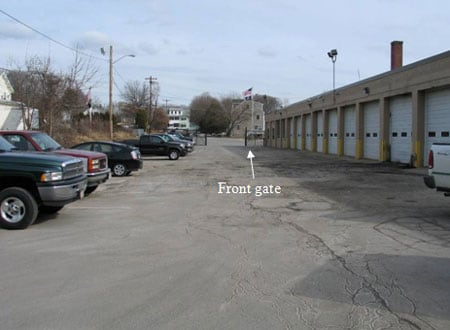 |
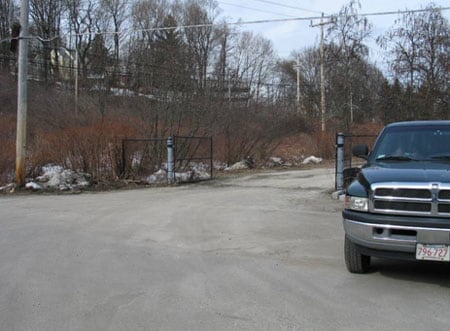 |
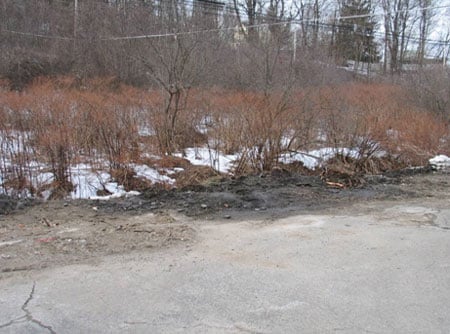
|
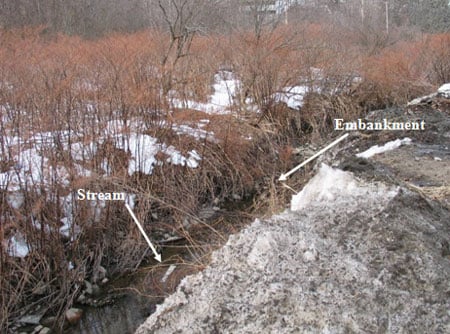
|
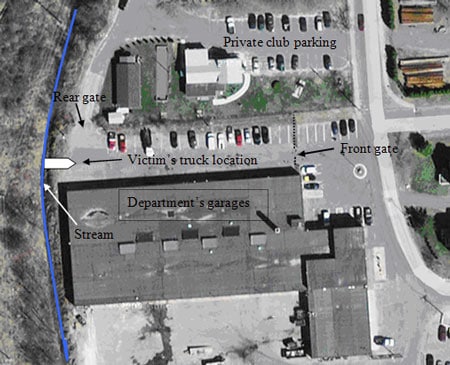
|
|
Figure 5 – Aerial view of incident location.
|
Reference
- DOL. OSHA. Job Hazard Analysispdf iconexternal icon. Publication Number: 3071. [www.osha.gov/Publications/osha3071.pdf]. Date accessed: March 8, 2010.
To contact Massachusetts State FACE program personnel regarding State-based FACE reports, please use information listed on the Contact Sheet on the NIOSH FACE web site Please contact In-house FACE program personnel regarding In-house FACE reports and to gain assistance when State-FACE program personnel cannot be reached.
